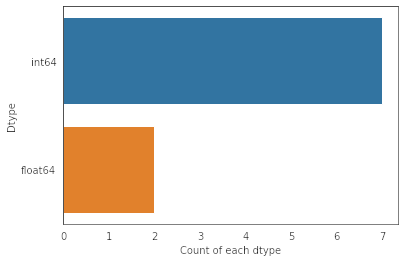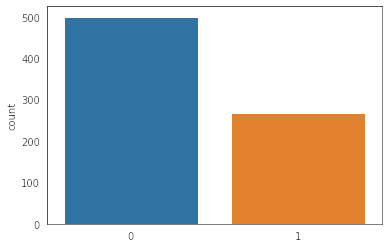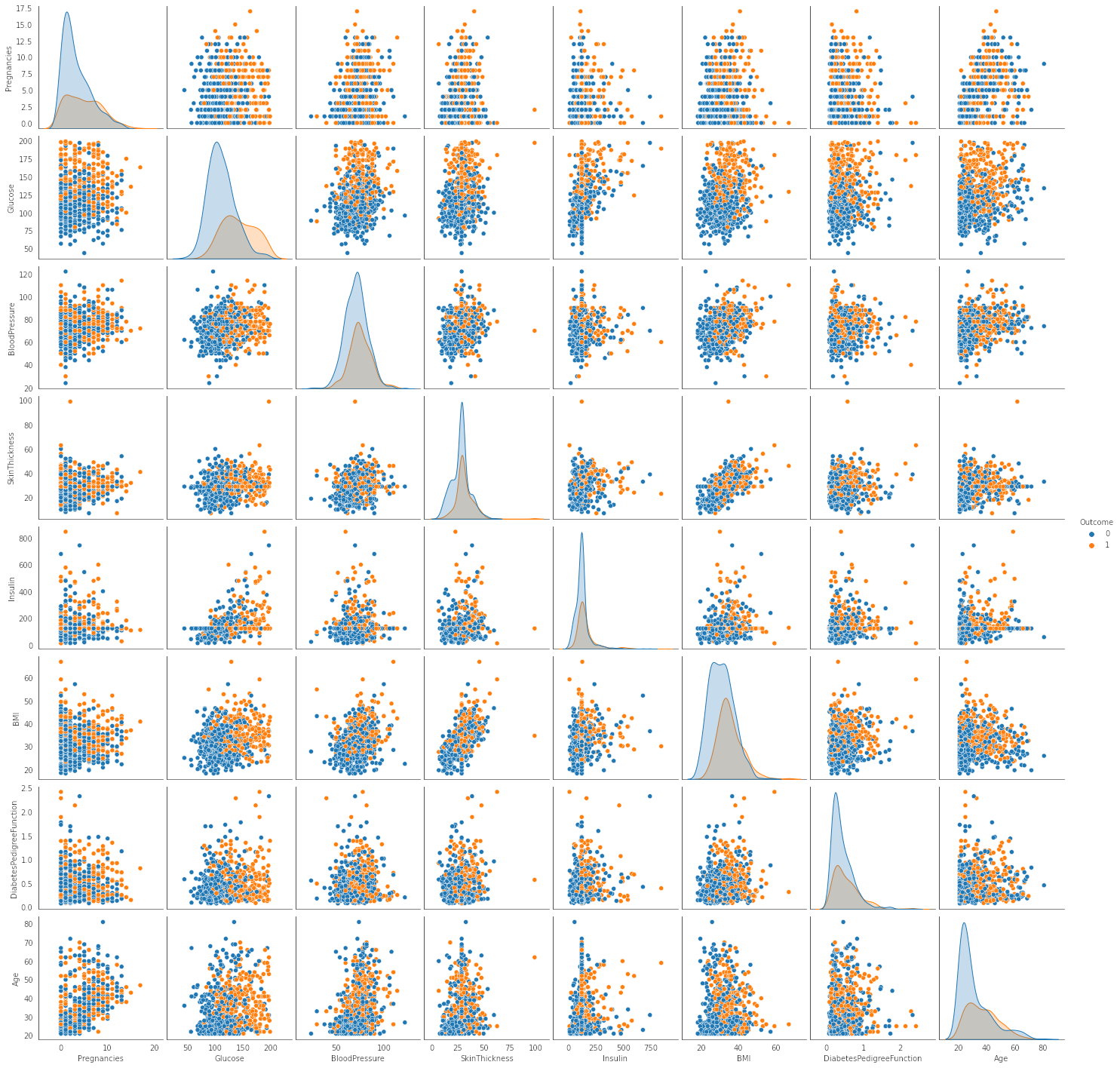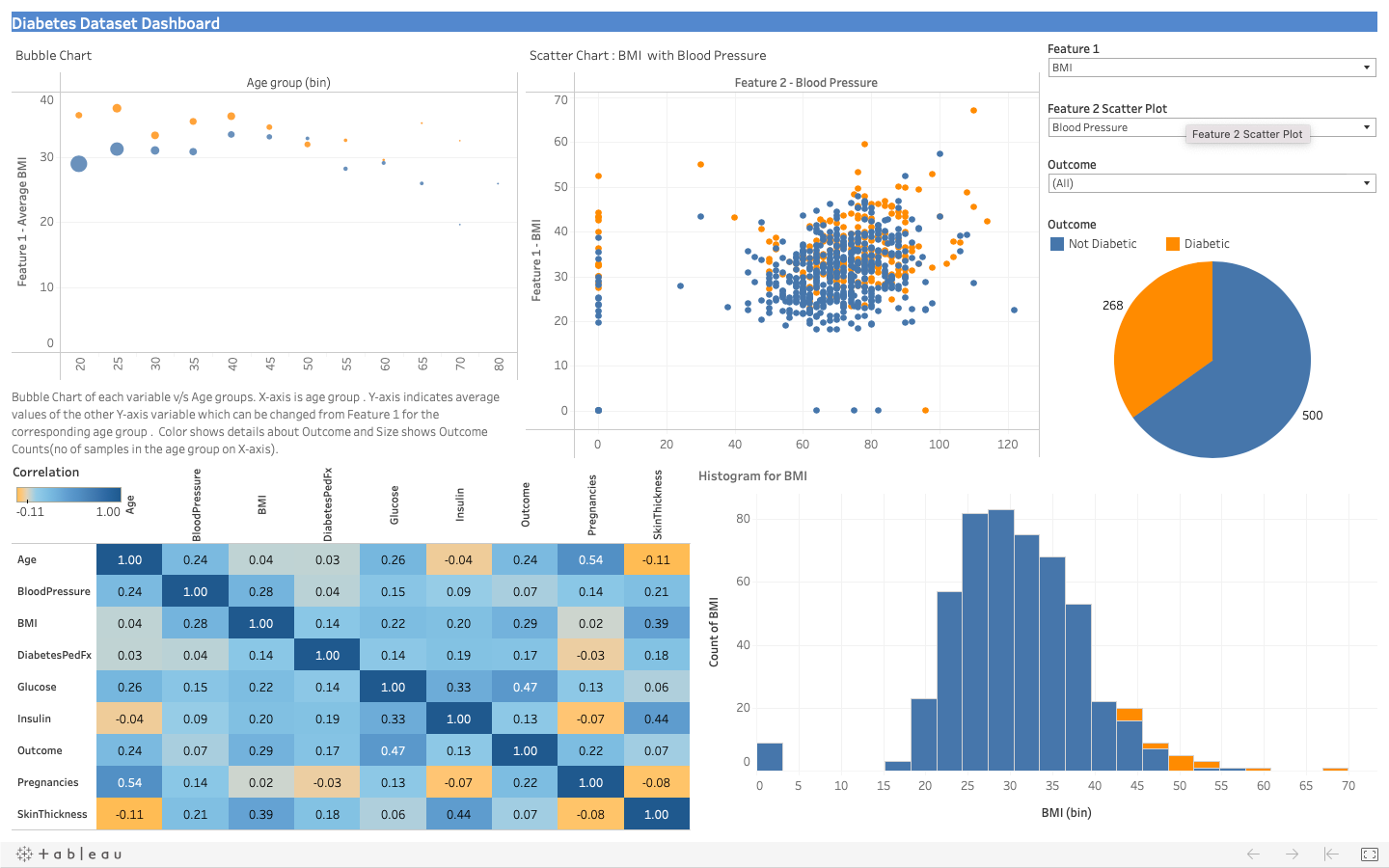

🏥👩🏽⚕️ Data Science Course Capstone Project - Healthcare domain - Diabetes Detection
This is comprehensive project completed by me as part of the Data Science Post Graduate Programme. This project includes multiple classification algorithms over a dataset collected on health/diagnostic variables to predict of a person has diabetes or not based on the data points. Apart from extensive EDA to understand the distribution and other aspects of the data, pre-processing was done to identify data which was missing or did not make sense within certain columns and imputation techniques were deployed to treat missing values. For classification the balance of classes was also reviewed and treated using SMOTE. Finally models were built using various classification algorithms and compared for accuracy on various metrics.Lastly the project contains a dashboard on the original data using Tableau.
You can view the full project code on this Github link
Note: This is an academic project completed by me as part of my Post Graduate program in Data Science from Purdue University through Simplilearn. This project was towards final course completion.
Bussiness Scenario
This dataset is originally from the National Institute of Diabetes and Digestive and Kidney Diseases. The objective of the dataset is to diagnostically predict whether or not a patient has diabetes, based on certain diagnostic measurements included in the dataset. Several constraints were placed on the selection of these instances from a larger database. In particular, all patients here are females at least 21 years old of Pima Indian heritage.
Build a model to accurately predict whether the patients in the dataset have diabetes or not.
Analysis Steps
Data cleaning and exploratory data analysis -.

There are integer as well as float data-type of variables in this dataset. Create a count (frequency) plot describing the data types and the count of variables.

Check the balance of the data (to review imbalanced classes for the classification problem) by plotting the count of outcomes by their value. Review findings and plan future course of actions.

We notice that there is class imbalance . The diabetic class (1) is the minority class and there are 35% samples for this class. However for the non-diabetic class(0) there are 65% of the total samples present. We need to balance the data using any oversampling for minority class or undersampling for majority class. This would help to ensure the model is balanced across both classes.We can apply the SMOTE (synthetic minority oversampling technique) method for balancing the samples by oversampling the minority class (class 1 - diabetic) as we would want to ensure model more accurately predicts when an individual has diabetes in our problem.
Create scatter charts between the pair of variables to understand the relationships. Describe findings.

We review scatter charts for analysing inter-relations between the variables and observe the following
Perform correlation analysis. Visually explore it using a heat map.

Observation : As mentioned in the pairplot analysis the variable Glucose has the highest correlation to outcome.
Model Building

Note: ROC (Receiver Operating Characteristic) Curve tells us about how good the model can distinguish between two things (e.g If a patient has a disease or no). Better models can accurately distinguish between the two. Whereas, a poor model will have difficulties in distinguishing between the two. This is quantified in the AUC Score. Final Analysis Based on the classification report:
Data Reporting

Tools used:
This project was completed in Python using Jupyter notebooks. Common libraries used for analysis include numpy, pandas, sci-kit learn, matplotlib, seaborn, xgboost
Further Reading
🏡🏷️ california housing price prediction using linear regression in python.
Summary- The project includes analysis on the California Housing Dataset with some Exploratory data analysis . There was encoding of categorical data using the one-hot encoding present in pandas. ...
🔎📊 Principal Component Analysis with XGBoost Regression in Python
Summary- This project is based on data from the Mercedes Benz test bench for vehicles at the testing and quality assurance phase during the production cycle. The dataset consists of high number of...
💬⚙️ NLP Project - Phone Review Analysis and Topic Modeling with Latent Dirichlet Allocation in Python
Summary- This is a Natural Language Processing project which includes analysis of buyer’s reviews/comments of a popular mobile phone by Lenovo from an e-commerce website. Analysis done for the proj...

Data Science Capstone
Skills / knowledge.
- Hadoop framework
- SQL database
- Machine Learning
- Data visualization
- Python and R Programming
- Data Analytics, Statistics
Academia.edu no longer supports Internet Explorer.
To browse Academia.edu and the wider internet faster and more securely, please take a few seconds to upgrade your browser .
Enter the email address you signed up with and we'll email you a reset link.
- We're Hiring!
- Help Center

Download Free PDF
SIMPLILEARN SampleProject1-Healthcare

John Goldsmith on scientific misconduct and the Lilienfeld study (An oldie but still relevant today)
Background to the Lilienfeld study and the “Moscow signal”:
In the early 1960s it was discovered that from 1953 the Soviets had been beaming highly focused microwaves directly into the US Embassy in Moscow at an estimated power density that ranged from .005 mW/cm2 to .018 mW/cm2.112 Averaged measurements determined that although the intensity reaching the Embassy was approximately 500 times less than the US standard for occupational exposure, it was twice the highest limit allowed in the Soviet standard.This created a quandary for the US, for if they truly believed their thermally-based 10 mW/cm2 standard was safe they could hardly conclude that the level of microwaves at their Embassy was undermining the health of the Embassy staff. Concerns were raised about the purpose of irradiation of the Embassy. Was it eavesdropping or a more sinister attack on the health of the employees? An initial study was done on the Moscow personnel in 1967 that examined a group of 43 workers, (37 exposed and 7 not exposed). They were tested for abnormalities in chromosomes and 20 out of the 37 were above the normal range among the exposed, compared to 2/7 among the non-exposed. In the final report the scientists urged a repeat and follow-up study which was clinically indicated for 18 persons, but was not undertaken by the end of the contract period, June 30, 1969. The evidence of chromosome changes was strong enough to have triggered clinical guidelines that would have recommended ceasing reproductive activity until the condition had improved. At a Superpower summit in June 1967 the irradiation of the Moscow Embassy was the subject of a confidential exchange between US President Lyndon Johnson and Soviet Prime Minister Alexi Kosygin. Johnson asked that the Soviet Union stop irradiating its Moscow Embassy with microwaves and harming the health of American citizens. In 1966 a covert study, called Project Pandora, was commenced to study the possible effects on health from the microwave irradiation of the Moscow Embassy staff, who were not told the true reason for the investigation. In a related study, Project Bizarre, a primate was exposed to microwaves at half that permitted by the US standard. The findings of this study concluded, “[t]here is no question that penetration of the central nervous system has been achieved, either directly or indirectly into that portion of the brain concerned with the changes in work functions”�.
A haematologic study by J & S Tonascia in 1976 found highly significant differences between Moscow Embassy employees and other foreign service staff (control group). White blood cell counts were much higher in the Moscow staff as well as several other significant changes noted over time. These results were never published, but obtained under the Freedom of Information Act. At this time there was a US Congressional radiation inquiry underway and the Department of Defense (DoD) was arguing that the US RF/MW Standard was already strict enough. They argued that there was no scientific evidence for the Soviet Standard being set at a level one thousand times lower than the US standard. The Moscow Embassy employees and dependants were studied for possible health effects of microwave irradiation by a team from John Hopkins University, under the direction of epidemiologist Professor Abraham Lilienfeld. Dr Lilienfeld noted that the study group was quite small and that the follow-up time too short to generally identify significant health effects such as cancer. He recommended that continued health status surveillance should be carried out, but this was not done. The incidence of sickness and death were compared with employees & dependents in other Eastern European embassies, and with the average US rates. The incidence of multiple-site cancers was far more frequent in the Moscow Embassy group than in any other population studied. It was noted that while multiple-site cancers are characteristic of older populations, the Moscow Embassy group was relatively young. According to Goldsmith, concerns of the John Hopkins team were “downgraded”� by the state department and the wording of the team report altered to lessen its impact. Lilienfeld strongly recommended that additional follow up studies be undertaken since the latency periods for some types of cancer had been insufficient for cancer to occur, if indeed it were to result from microwave exposure. Nevertheless, according to Goldsmith, the overall findings were consistent with excess cancer incidence both in the Moscow Embassy cohort and in the other Eastern European embassy personnel.Data on exposure and occurrence of some cases of cancer were withheld from Professor Lilienfeld until after his report was completed and it was too late to include in the results. Reviews of the work done by contract investigators were interpreted as inconclusive because the State Department had failed to complete the necessary follow-up work which was recommended by the Lilienfeld team.
From The Procrustean Approach , pp. 105 – 107
*******************************************************
From Iris Atzmon, June 1, 2012:
Where the trail leads… Ethical problems arising when the trail of professional work lead to evidence of cover-up of serious risk and mis-representation of scientific judgement concerning human exposures to radar
– Prof. John R. Goldsmith, M.D., M.P.H.
Epidemiology and Health Services Evaluation Unit, Faculty of Health Sciences, Ben Gurion University of the Negev, P.O.B. 653, 84105 Beer-Sheva, Israel Eubios Journal of Asian and International Bioethics 5 (1995), 92-4. Introduction
Professional interaction over fifteen years between myself, an epidemiologist, and a lawyer started in 1974, when we were both in Washington, evaluating environmental health problems. The lawyer, recently disappointed with the outcome of a case which hinged on the testimony of an epidemiologist, began a dialogue about the criteria for use of probabilities in the scientific and judicial system. We agreed on the importance of making clear these differences, and he documented them in an article.
These differences can be misused in both legal and scientific procedures, under circumstances in which the failure to demonstrate conventional statistical significance (scientifically) is erroneously interpreted as meaning that preventing exposure would not be a reasonable public health measure.
When the lawyer started his private practice he sought expert epidemiological advice in the case of foreign service workers with cancer who had been exposed to microwave radiation in the US Embassy in Moscow.
The trail then led to a major investigation of health risks of Embassy staff by a leading U.S. epidemiologist. The report of this study was said to be negative but actually had some disturbing findings. The trail took a sharp turn when the lawyer provided me copies of documents, obtained under the Freedom of Information Act, which indicated persistent cover-up and deliberate distortions of views of highly regarded scientists with respect to risks from these exposures. A published report on personnel risks from radar exposure in the U.S. Navy diluted the experience of increased leukemia in an exposed group with the low rates in a less exposed group, bringing down likelihood of a significant result and concluding that no effect occurred.
The ethical issues concern whether a scientist who inadvertently finds this evidence should disclose it, in light of security considerations among other matters. The trail, in this presentation, ends with an application of the legal use of probability in interpreting epidemiological evidence on the central scientific issue, the possible health risks from microwave radiation.
For the full paper: http://www.eubios.info/EJ54/EJ54H.htm
- -Mailing List ,
- Corporate influence on Science, government and the military ,
- Tobacco science and the art of spin
Blog Categories
- -Mailing List
- 5G and beyond
- A Brave New World: A dystopian high-tech future
- ACEBR Watch
- Alternatives to ICNIRP Hegemony
- America's revolving door between govt. Agencies and corporate America
- Bioinitiative Report
- Book reviews/new books of interest
- Breast cancer and childhood leukaemia
- Broadband over Power Lines (BPL)
- Cancer clusters
- Cell phone addiction
- Cell phone news
- Cell Phone Towers
- Chemical and mould Exposures
- Community / Citizens Organisations
- Conferences
- Corporate influence on Science, government and the military
- DECT, Wi-FI, and WLAN wireless systems and health
- Electromagnetic Hypersensitivity
- Electrosmog effects on birds and bees
- Epidemiology
- Fukushima, Chernobyl and ionizing radiation
- Genetically Modified crops
- Globalization / Harmonization
- Literature reviews
- Microwave effects on wildlife
- Miscellaneous
- On ICNIRP and WHO
- Peer review problems
- Plastics and Human Health
- Publications
- Smart Meters, appliances, technology and the Internet of Things
- The Effects of Technology on Children
- The Science Media Centre model of science communication
- Trumpism and the attack on science
- Wi Fi technology in schools
- Wind turbine issues
Photostream
Post Graduate Program In Business Analysis, Moscow
- Become a certified Business Analyst in 6 Months!
- Master data-driven problem-solving techniques
- Learn Power BI, Tableau, Advanced Excel & more
- Refine workflows with AI Powered Business Analysis
Application closes on : 28 th Oct
Application closes on
Program duration
Learning Format
Why Join this Program
Certificate from Simplilearn in collaboration with Purdue University
- Become an AI-powered Business Analyst via ChatGPT and Gemini
Earn 35 PDs/CDUs post-completion of the CBAP® module
Resume assistance, career mentoring, and job portal access for India and US learners
Take the first step to your goals
Lifetime access to self-paced e learning content
Corporate Training
Enterprise training for teams
Business Analysis Course Overview
This program is perfect for graduates and professionals preparing for a Business Analyst role. With masterclasses by Purdue faculty and live sessions by industry experts, it combines self-paced learning and live online classes for well-rounded training. This program offers hands-on practice via real-world case studies, capstones, and mini-projects.
Key Features
- Get mentored and network with industry experts from Amazon, Microsoft, and Google
- Access Harvard Business Publishing case studies of Pearson, CarMax, EvCard, etc
- Become eligible to be part of the Purdue University Alumni Association
- Get hands-on experience with capstone projects from 3 domains and 14+ projects
- Learn AI-powered Business Analysis leveraging ChatGPT and Gemini
- Certificate from Simplilearn in collaboration with Purdue University
- Earn 35 PDs/CDUs post-completion of the CBAP® module
- Master Classes delivered by notable Purdue faculty
PG Certificate in Business Analytics Advantage
Master requirement analysis, product vision, Agile methodologies, analytics, and modeling. Gain Excel, PowerBI, and Tableau expertise, and earn credentials from Purdue University and 35 PDs/CDUs from IIBA.

Partnering with Purdue University
- Master Classes delivered by Purdue faculty
Business Analysis Course Details
Master industry-relevant business analysis skills. Learn core business analytics, modeling, and reporting skills with mini hands-on projects, Harvard Business Publishing case studies, and one capstone project. Become industry-ready with an IIBA-accredited CBAP course.
Learning Path
Accelerate your Business Analysis career with preparatory courses on statistics fundamentals, SQL databases, and business analysis basics
- Acquire business analysis skills like advanced documentation, effective planning, and business solutions design.
- Learn about lifecycle management, planning and monitoring, requirement and strategy analysis, and the agile perspective.
- Learn Excel to make sophisticated data analytics and arrive at business decisions.
- Work with SQL databases and utilize the database in your applications.
- Manage SQL databases for scalable development - learn conditional statements, joins, subqueries, commands, and other tools.
- Learn Power BI concepts like Microsoft Power BI Desktop layouts, BI reports, dashboards, Power BI DAX commands, and functions.
- Learn to experiment, fix, prepare, and present data quickly and easily.
Tableau Desktop 10 will help you gain a variety of skills on the powerful platform like:
- Visualization Building
- Data Organization
- Dashboard Design
- Build an industry-relevant capstone project in three domains: Retail, Banking, and Hospitality.
- The capstone project will help bring together every course into one portfolio-worthy capstone.
- Attend an online interactive masterclass and get insights about advancements in technology/techniques in Business Analysis.
- This course teaches learners to analyze data and make informed decisions using the R programming language.
- Leverage digital technologies to transform your business strategies and objectives.
- This course can prove crucial for leaders across all business domains.
- It is designed to help you build a solid action plan, foster customer-focused innovation, and drive a digital culture in your organization.
- Attend this online interactive industry master class to gain insights about Business Analyst Trends from top Industry Experts.
- Harness the power of ChatGPT and Google Gemini to enhance productivity, streamline workflows, and effectively utilize their time in conducting business analysis.
- This program aims to empower business analysts by equipping them with essential knowledge and skills to integrate ChatGPT and Gemini seamlessly into everyday work practices.
- Imbibe the Agile Scrum project management approach and enhance your ability to develop and deliver quality products to customers.
- Learn the best practices of Agile and the nuances of the Scrum methodology to help you maximize business value and mitigate risks.
+44 20 3627 9615
19+ skills covered.
- Business Analysis
- Elicitation and Collaboration
- BRD FRD and SRS Document Creation
- Requirements Analysis
- Planning and Monitoring
- Requirements Life Cycle Management
- Strategy Analysis
- Wireframing
- Solution Evaluation
- Dashboarding
- Data Visualization
- Agile scrum methodology
- Scrum Artifacts
- Statistical Analysis using Excel
- SQL Database
- Data analysis
- Digital Transformation
- ChatGPT and Generative AI
10+ Tools Covered
Case Studies and Projects
Pearsons successmaker.
[Harvard Case Study] Step into shoes of the VP of Product at Pearson, to transform the product development processes to better meet the needs of customers in the education market
Amazon Facing Low Customer Satisfaction in Singapore
[Harvard Case Study] As the lead analyst at the ISE, analyse customer surveys to identify the factors behind why Amazon ranked last in terms of customer satisfaction in Singapore.
PGA Golf Is Sunday Made for TV
[Harvard Case Study] Analyse a Golf tournament to identify if courses were made easier on Sunday to telecast low scores or if the pressure on the golfers raised their scores.
Canteen Ordering System for Unilever
Design an online portal for Unilever Canteen that enables employees to order food online to decrease employee waiting time and increase the chance of getting preferred food items.
Library Management System for Stanford
Design a library management software for Stanford University to automate library activities like providing accurate information regarding any book, magazine, and research papers.
WhatsApp Pay
Help WhatsApp design a business model to help at least one million users get on board with the WhatsApp Pay feature within the first three months of its launch.

Hospital Management System for The Mayo Clinic
Design a hospital management system for Mayo Clinic to manage and coordinate cross-departmental administrative activities like patient records, bed availability, and more.
Disclaimer - The projects have been built leveraging real publicly available datasets from organizations.
Program Advisors and Trainers
Program advisors.

Dr. Zhiwei Zhu
With over 15 years of experience leading business analytics functions at global reinsurance companies, Dr. Zhu now uses his wealth of knowledge and business-relevant experience to provide analytics training to future business leaders at Purdue University’s Krannert School of Management.

Jeff Allen is a highly regarded project management and Agile expert with more than 15 years of experience at large companies like Compaq and HP. As an Agile Coach, he has mentored over 5000 professionals globally.

Bryan Campbell
Bryan Campbell is a highly respected Agile Coach and Project Manager with more than 25 years of experience managing projects, programs and PMOs around the world. He specializes in agile transformation for enterprise, scale PMOs.
Program Trainers
Junaid Javeed
United airlines.
Nagraj Chepuri
Self employed.
Gagandeep Siidhu
Senior assistant vp.
Abhay Shukla
Senior director.
Manjunatha Gummaraju
At business consulting, join the business analyst industry.
The size of the business analytics industry is projected to grow from USD 46.33 billion in 2024 to USD 90.67 billion by 2032, exhibiting a CAGR of 8.50% during the forecast period (2024 - 2032).
Business Analysis as a skill in 2020
of Business Analysis profile by 2028
Average Salary
Hiring Companies
Batch Profile
This program caters to working professionals from a variety of industries and backgrounds; the diversity of our students adds richness to class discussions and interactions.
- Work Experience The class maintains an impressive diversity across work experience and roles Designation Manager - 20% Analyst - 20% Associate/ Consultant - 35% Executive/Senior - 15% Engineer - 10% Total Years of Experience Less than 3 years - 10% 3-5 years - 35% 5-8 years - 35% 8+ years - 20%
Learner Reviews
Admission details, application process.
The application process consists of three simple steps. An offer of admission will be made to the selected candidates and accepted by the candidates by paying the admission fee.
Submit Application
Tell us a bit about yourself and why you want to do this program.
Application Review
An admission panel will shortlist candidates based on their application
Selected candidates can begin the program within 1-2 weeks
Eligibility Criteria
For admission to this Business Analysis program, candidates should have:
Admission Fee & Financing
The admission fee for this Business Analysis Program is € 1,990. This fee also includes all applicable program charges including Purdue Alumni Association Membership fees.
Financing Options
We are dedicated to making our programs accessible. We are committed to helping you find a way to budget for this program and offer a variety of financing options to make it more economical.
Total Program Fee
Pay in installments, as low as.
You can pay monthly installments for Post Graduate Programs using Splitit payment option with 0% interest and no hidden fees.
Program Benefits
- Complete this program while you work
- Rigorous curriculum designed by industry experts
- Alumni Association Membership from Purdue University
- Active recruiters include Google, Microsoft, Amazon and more
Program Cohorts
Next cohort.
31 Oct, 2024
23 Nov, 2024 - 29 Jun, 2025
16:30 - 20:30 MST
Weekend Sa Su
PGP Business Analysis Course Moscow FAQs
Who are the instructors for this pg business analytics course, and how are they selected.
The instructors who lead our courses are highly qualified and have years of industry experience. Each of them goes through a rigorous selection process that includes profile screening, technical evaluation, and a training demo before they are given the certification of training. We also ensure that trainers with a high alumni rating remain part of our faculty.
What is the admission process for this Post Graduate Program in Business Analysis in collaboration with Purdue University?
The admission process for this Post Graduate Program in Business Analysis consists of three simple steps:
- All interested candidates are required to apply through the online application form
- An admission panel will shortlist the candidates based on their application
- The selected candidates will receive an offer of admission, which they will accept by paying the program fee
What are possible career paths after completing the Post Graduate Program in Business Analysis?
After completing this post graduate in business analytics program, you can pursue job roles like business analyst, data analyst, IT analyst, and more.
Is any financial aid provided for this Post Graduate Program in Business Analysis?
To ensure that money is not a barrier to learning, we offer various financing options to help make this program financially manageable. Please refer to our “Admissions Fee and Financing” section for more details.
Can MBA graduates pursue a post graduate certificate in business analysis?
Absolutely! The Post Graduate Program in Business Analysis is an excellent choice for MBA graduates seeking to enhance their skill set in business analysis. By combining the strategic thinking acquired in MBA courses with the specialized knowledge and practical skills offered in this business analytics bootcamp, graduates can become well-rounded professionals capable of making data-driven decisions and achieving successful business outcomes. Certifications from recognized bodies like the International Institute of Business Analysis (IIBA®) can further enhance the credentials of MBA graduates.
What is BABOK®, and what does it cover?
The Business Analysis Body of Knowledge® (BABOK® Guide) helps a certified business analyst achieve better business outcomes at strategic, tactical, and operational levels. BABOK covers knowledge areas, techniques, and perspectives that represent the majority of business analysts' tasks and provides focus on tasks and techniques specific to the initiative's context.
I am unable to access the online business analysis course. Who can help me?
If you cannot access the business analysis course after paying the fees, fill out the form on your right, available on the Course pages. You can cite your issue on the form, and our customer support team member will get back to you as soon as possible. Contact us via the Live Chat link or the Grievance Redressal tab .
Can I get a refund if I want to cancel my enrollment in this PG in business analytics program?
Please read our refund policy for information about cancellations and refunds regarding our business analyst course. Alternatively, you can contact us by email, telephone, or live chat if you need any assistance. * Disclaimer All programs are offered on a non-credit basis and are not transferable to a degree.
What is covered under the 24/7 support promise?
Our committed team is here to assist you through email, chat, calls, and community forums. On-demand support is available to guide you through the Post Graduate Program In Business Analysis. Once you finish the PG in business analytics, you will gain lifelong access to our community forum.
Find Business and Leadership Programs in Moscow
- PMP, PMI, PMBOK, CAPM, PgMP, PfMP, ACP, PBA, RMP, SP, OPM3 and the PMI ATP seal are the registered marks of the Project Management Institute, Inc.

IMAGES
VIDEO
COMMENTS
I worked on this capstone project towards completion of final assessment for PGP in Data Science course from Simplilearn-Purdue University. My job was to analyze the datasets from NIDDK consisting of several medical predictor variables and one target variable (Outcome). Predictor variables includes the number of pregnancies the patient has had ...
Data_Science_Capstone. Health Care Project of Simplilearn. DESCRIPTION. Problem Statement NIDDK (National Institute of Diabetes and Digestive and Kidney Diseases) research creates knowledge about and treatments for the most chronic, costly, and consequential diseases. The dataset used in this project is originally from NIDDK.
Find the percentage of rows that have trivial value (for example, ?), and delete such rows if they do not contain significant information Use the necessary transformation methods to deal with the nominal and ordinal categorical variables in the dataset The dataset has State ID, which has around 16 ...
Capstone projects serve as a culmination of a student's academic journey. It requires them to draw upon knowledge and skills acquired throughout their studies. This integration of various disciplines provides a deeper understanding and appreciation of the interconnectedness of different subjects. A capstone project also increases students ...
Healthcare Simplilearn Capstone Project by Alexander Schmig. Details . 2 455. Healthcare Simplilearn Capstone Project . Published: Jun 29, 2021 Updated: Dec 6, 2022. English (US) Deutsch; English (UK) English (US) Español; Français (Canada) Français (France) Italiano;
Something went wrong and this page crashed! If the issue persists, it's likely a problem on our side.
Data Science Capstone - Healthcare The objective is to predict whether or not a patient has diabetes, based on certain diagnostic measurements included in the dataset. #simplilearn #mushtaqueViz #CapstoneProject. Published: Aug 22, 2021 Updated: Dec 7, 2022. English (US) Deutsch; English (UK) English (US)
Summary- This is comprehensive project completed by me as part of the Data Science Post Graduate Programme. This project includes multiple classification algorithms over a dataset collected on health/diagnostic variables to predict of a person has diabetes or not based on the data points. Apart from extensive EDA to understand the distribution and other aspects of the data, pre-processing was ...
Also, we will refurbish our EDA skills too with this project. Diabetes Retinopathy: It is a computer vision problem. Computer vision is widely applied in the field of healthcare and is a must-have skill for anyone wishing to apply AI in healthcare mainly because a lot of healthcare data is in the form of diagnostic images e.g. MRI's, etc.
SimpliLearn-Capstone-Project--Healthcare. DESCRIPTION. Problem Statement NIDDK (National Institute of Diabetes and Digestive and Kidney Diseases) research creates knowledge about and treatments for the most chronic, costly, and consequential diseases. The dataset used in this project is originally from NIDDK.
Simplilearn's Data Science Capstone project gave learners an opportunity to implement the skills learned in the Data Science certification course. Through dedicated mentoring sessions, learners understood how to solve a real-world, industry-aligned Data Science problem - from data processing and model building to reporting business results and insights. As the final step in their Data ...
Simplilearn's Data Science Capstone project will give you an opportunity to implement the skills you learned in the Data Science course. Through dedicated mentoring sessions, you'll learn how to solve a real-world, industry-aligned Data Science problem, from data processing and model building to reporting your business results and insights.
The data science and machine learning capstone project provides a unique opportunity to apply skills in real-world scenarios. ... finance and healthcare. For more information on what a data science professional does, refer to our article. What influence will Data Science have in 2024? ... Simplilearn's PG data science program in collaboration ...
Data Science Capstone Project Using Python and Tableau 10. DESCRIPTION. Problem Statement NIDDK (National Institute of Diabetes and Digestive and Kidney Diseases) research creates knowledge about and treatments for the most chronic, costly, and consequential diseases.
Ambika Sinha GTA, Simplilearn Project 1: Analyze the Healthcare cost and Utilization in Wisconsin hospitals Contents Business Scenario 2 Expected Outcome: 2 Workflow Description 3 R- Code for Project 3 Function Explanations 4 Analysis 5 To record the patient statistics, the agency wants to find the age category of people who frequent the hospital and has the maximum expenditure. 5 In order of ...
How Can Simplilearn Help You? If you're looking to become a business analyst, then our latest creation Post Graduate Program in Business Analysis is a brilliant choice. The course will cover the A-Z of Business Analysis and you will also work on hands-on, industry-relevant capstone projects in three different domains. FAQs 1.
This Repository contains codes for simplilearn capstone project - Simplilearn-Capstone/Case Study - healthcare Industry.docx at main · abhishekJadhav/Simplilearn ...
In 1966 a covert study, called Project Pandora, was commenced to study the possible effects on health from the microwave irradiation of the Moscow Embassy staff, who were not told the true reason for the investigation. In a related study, Project Bizarre, a primate was exposed to microwaves at half that permitted by the US standard.
Post Graduate Program In Business Analysis, Moscow. Become a certified Business Analyst in 6 Months! Master data-driven problem-solving techniques with essential business analysis tools like Power BI, Tableau, Advanced Excel, and AI tools like ChatGPT and Gemini.